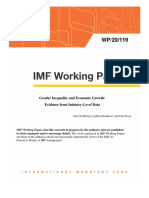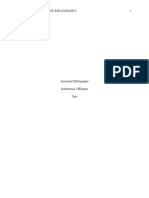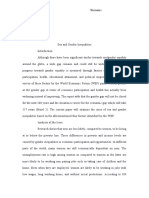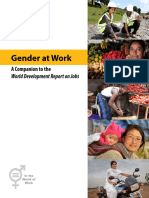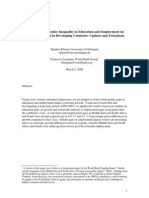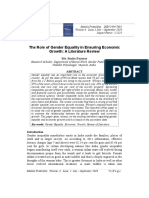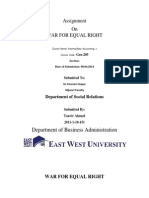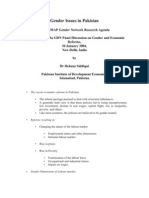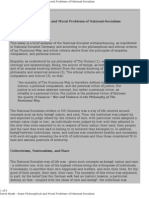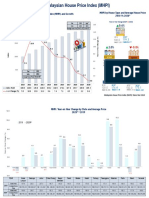Table of content:
Introduction………………………………………………………………………………………. 2
Journal reviews……………………………………………………………………………............
3
Conclusion………………………………………………………………………………………...
6
References………………………………………………………………………………………... 7
Marking Scheme…………………………………………………………………………………..
9
1
�Introduction:
Discrimination is defined as any negative treatment of anybody based on their gender,
race, or other characteristics (Goldberg, 2010). It is regarded as a barrier to the attainment of the
goals of equality, progress, and peace. Discrimination is acknowledged as a type of inequality
and a problem for women all around the world. It has an impact on women's ability to engage
freely and completely in society, which has psychologically negative effects. Women make up
half of the world's population and continue to face discrimination in many stages of life, whether
directly or indirectly, despite variances in each country, religion, community, or race. According
to the World Economic Forum's most recent Gender Gap Report 2020, the worldwide gender
difference in education, economic opportunity, and politics has shrunk by 6% in the last decade,
while the economic gap has closed by 58%. Extrapolating from this track, the study concludes
that it will take another 276.6 years –or until 2297– for the globe to completely close the
economic gap (Crotti et al, 2020). Two conflicting tendencies are behind the poor progress in
narrowing the economic gap between the genders. On the one hand, the share of women among
trained professionals is increasing, as is progress toward salary equality, albeit at a slower rate.
On the other hand, general income gaps are only partially bridged, and there remains a
continuing paucity of women in leadership roles, with women accounting for only 27% of all
management positions. Gender disparities are most visible in the workplace. For example,
women are more likely than males to work part-time, labour in low-paying jobs, and not hold
managerial roles (Arulampalam, Booth and Bryan, 2007). There is evidence that gender
disparities in the workplace are caused, at least in part, by gender discrimination. Indeed,
numerous studies have demonstrated personal discrimination against women by decision makers,
with some particularly examining the influence of decision makers' sexist views on
discriminatory actions. For example, Masser and Abrams (2004) discovered in an experimental
study that the higher the participants' hostile sexism score, the more likely they were to propose a
male applicant rather than a female candidate for a managerial position. Despite continuous
evidence that increased sexism is associated with greater bias against working women, little is
understood about the underlying mechanisms that link sexism to discrimination. This is an
essential topic, particularly because the continuance of gender discrimination violates the anti-
discrimination norms espoused in modern countries.
Journal reviews:
2
� Several theoretical and empirical investigations have found that gender disparity in
education and employment lowers economic development. In terms of gender disparity in
schooling, the theoretical literature of Altuzarra et al (2021) presents empirical data on the
consequences of gender disparities on economic growth. For the period 1990–2017, the study
utilized data from the World Bank's database with a wide panel of 105 developing nations. The
findings indicate that gender equality in education promotes economic growth, which is a typical
trait in emerging nations. The study proposes as a preliminary argument that such gender
imbalance decreases the average quantity of human capital in a society, therefore harming
economic performance. It accomplishes this by artificially limiting the pool of talent from which
to draw for schooling.
Furthermore, Ezeh (2020) investigated the effect of gender disparity in education on
economic growth in Sub-Saharan African nations. The difference in female to male primary and
secondary enrolment was one of two gender inequality metrics utilized. The Solow Model served
as the foundation for the study, which was supplemented with human capital and health care
expenditure per capita, and the study is based on yearly from 1990 to 2018. The major findings
of this article show that there is a statistically significant negative link between gender disparity
in elementary and secondary education and economic growth, as well as a negative influence of
female labour participation on economic growth.
There are arguments concerning gender disparities in employment. A study done by
Plickert and Sterling (2017) explored how work schedules differ by personal disposition and
workplace factors, comparing full-time versus part-time work, using survey data from a national
representative U.S. panel study of attorneys. The study explored the impact of dedication to
work, performance, ideal worker expectations, practise environments, and job satisfaction on the
work schedules of women and men attorneys, using common theories of gender disparity in the
legal profession. Work schedules differ considerably by gender, parental role, and experience
with workplace discrimination, according to the results of a logistic regression analysis. The
study discovered that, whereas all parents face some form of discrimination, there are still
significant disparities in work schedules between women and men. By investigating statistically
3
�experiences of workplace discrimination, the study contributed to the gender debate in
employment and organizations.
Besides that, another study done by Stuart et al (2018) centers around women’s economic
empowerment and self-governance as a technique for accelerating gender equality
correspondence through the execution of the Sustainable Development Goals (SDGs), in which
provides a framework for mainstreaming gender inequality issues. In presenting this defense, the
paper centers around a portion of the key hindrances that the Caribbean subregion has in its
endeavors to accomplish greater balance, remarkably gender equality and to advance sustainable
development for all. The study came to a conclusion that it is important that women have equal
access to productive job and income-generating opportunities that promote their empowerment
by providing the appropriate enabling frameworks to increase their economic autonomy.
In addition, another study done by Rodriguez (2018) investigates the link between labour
market feminization, characterized as a proportionate expansion in female workforce interest and
female work supply as estimated in hours, and financial development in five Latin American
countries. From one viewpoint of the study, the market trend are reflected in the potential interest
that workforce cooperation can channel into financial development. On the other, the conditions
under which women enter and stay in the work market will decide their supply side commitment
to economic development. Work supply capacities were determined utilizing the stock as far as
hours, feminization rates and assessed compensation in powerful financial development
capacities. The outcomes show that the feminization of the workforce bears a positive
relationship with development however that expansions in the work supply (as estimated in
hours) does not.
There is widespread agreement that improving women's property rights is critical for
decreasing poverty and ensuring equitable growth. Despite its relevance, insufficient nationally
representative statistics on women's property rights exist in Asia, making it difficult to develop
suitable policies to eliminate gender disparities in land rights. A study done by Kieran et al
(2015) examined existing micro-level, large-sample data on men's and women's land control and
used this information to analyze land rights disparities. The study computed five variables using
4
�nationally representative individual-and plot-level data from Bangladesh, Tajikistan, Vietnam,
and Timor-Leste. In spite of varieties in planning and overview procedure, all lists of
landownerships and the executives across the four countries show that guys own more land than
ladies, and men landowners as well as supervisors control more land than ladies landowners or
potentially managers.
In addition, a research done by Akter et al (2017), adds to the geological extent of the
literature by introducing observational proof of sex disparity from four Southeast Asian nations:
Myanmar, Thailand, Indonesia and the Philippines. It was found that when women in rural
regions have equal access to financing, equipment, modern technology, and agricultural inputs
such as fertilizer, their agricultural outputs are the same as men's; when they don't, they produce
10 to 12 percent less. It distinguished that putting women on an equal playing field in an
agricultural sector will result in a 3 to 4% increase in GDP while simultaneously decreasing
hunger and boosting food security.
Next, a research done by Njieassam (2019) studied the possibilities of including
indigenous women in Cameroon's government and decision-making processes with the
expectation that they will be included in critical decision-making processes that impact them,
decreasing their economic and social vulnerabilities. It was found that indigenous women in
Cameroon are frequently marginalized in comparison to nonindigenous women. The study
concluded that despite the fact that there are no dependable measurable information to back up
this contention, it is seen that indigenous women record high rates of assault, maternal and death
rates, sex based savagery, preventable and transmittable illnesses, and lack of education, and
have restricted rights to legacy and property.
A major research in Ethiopia employed geospatial analysis to compare the care-seeking
behaviour of male and female toddlers up to the age of five. From February to March2 016, a
community-based cross-sectional study of rural moms in the Aneded region was conducted. The
findings from Simieneh et al (2019) were that in areas where sons were preferred, female
children had less access to health care. Due to unequal access to care, women and girls are not
only less likely to receive treatment for disease, but they are also less likely to receive
5
�preventative measures such as vaccinations. The study also found that women in
underdeveloped nations who are economically reliant on males must seek cash from husbands
and dads to access health care. Because males are more inclined to spend money on their own
health care, women are more likely to avoid seeking health care or to turn to informal healers and
lower-cost medications. Women are usually unable to make decisions about obtaining treatment
on their own, but must first obtain permission from males, in-laws, or elder family members who
function as gatekeepers. In many situations, women must seek permission to leave the house, and
they must rely on men to take them to clinics.
Another study done by Brinda et al (2015) found that infant and maternal mortality are
highest in areas with the lowest gender equality. Poor health impairs an individual's capacity to
make a living, and the increased care load impairs the ability of other family members to earn a
living as well. Illness disrupts schooling as well as the supply of domestic goods and services
critical to family survival, such as cooking, childcare, and water collection. Furthermore, the
study concluded that bad health outcomes incur extra costs when costly medicines, transportation
to treatment, surgeries, and other health-care expenses are necessary. All of these effects clearly
contribute to family poverty; poor health, by extension, diminishes community economic power.
Based on the findings of the past literatures, I feel that we have made significant progress
in recent history toward gender equality, but we still have a long way to go to assure equal
endowments, participation, and voice for women. Despite this significant gain, significant gender
disparities persist. These vary in severity from nation to country and take various forms, ranging
from physical violence and deprivation to uneven chances in employment or daily life. Gender
equality is a fundamental human right regardless of where you live. Thus, encouraging gender
equality is essential to all aspects of a healthy society, from poverty reduction to promoting girls'
and boys' health, education, protection, and well-being.
Conclusion:
Many activities that exacerbate gender inequality have been highlighted as contributing
to and sustaining poverty. Women's economic inequality is systematic, as evidenced by broad
institutions ranging from inheritance laws to lending practices. The few examples given here
demonstrate that the various factors holding women back and making them vulnerable are
6
�mutually reinforcing; when combined, they form an almost impenetrable barrier preventing
women from full economic participation, making poverty in gender-unequal nations an
unavoidable and self-perpetuating scourge. None of the activities and occurrences described here
are distinctive cultural norms, but rather country-wide, regional-wide, or even global patterns
that apply to women as a class wherever they exist. The worldwide impact of gender inequity is
tremendous. After all, women constitute half of the species; how can the global effect of
women's poverty and hardship be seen as a small concern? Gender inequality is frequently
legislated and enforced via violence. Simple theories based on "self-selection" and "free choice"
overlook structural reality. Nobody chooses to be dependent and vulnerable, exposed to pressure,
abuse, and poverty. The global economy is still under threat from structural injustice, which
directly impacts half of the world's population and causes significant harm, particularly to the
poorest. Economic development and international policy initiatives must stop treating gender
disparity as a symptom of poverty and start addressing it as a key underlying cause.
(2045 words)
4.0 References:
Akter, S., Rutsaert, P., Luis, J., Htwe, N. M., San, S. S., Raharjo, B., & Pustika, A. (2017).
Women’s empowerment and gender equity in agriculture: A different perspective from Southeast
Asia. Food Policy, 69, 270-279.
Altuzarra, A., Gálvez-Gálvez, C., & González-Flores, A. (2021). Is gender inequality a barrier to
economic growth? A panel data analysis of developing countries. Sustainability, 13(1), 367.
Arulampalam, W., Booth, A. L., & Bryan, M. L. (2007). Is there a glass ceiling over Europe?
Exploring the gender pay gap across the wage distribution. ILR Review, 60(2), 163-186.
Brinda, E. M., Rajkumar, A. P., & Enemark, U. (2015). Association between gender inequality
index and child mortality rates: a cross-national study of 138 countries. BMC public health,
15(1), 1-6.
Crotti, R., Geiger, T., Ratcheva, V., & Zahidi, S. (2020). Global Gender Gap Report 2020. In
World Economic Forum. http://www3. weforum. org/docs/WEF_GGGR_2020. pdf.
Ezeh, K. (2020). Gender inequality in education and economic growth.
7
�Goldberg, S. B. (2010). Discrimination by comparison. Yale LJ, 120, 728.
Kieran, C., Sproule, K., Doss, C., Quisumbing, A., & Kim, S. M. (2015). Examining gender
inequalities in land rights indicators in Asia. Agricultural Economics, 46(S1), 119-138.
Masser, B. M., & Abrams, D. (2004). Reinforcing the glass ceiling: The consequences of hostile
sexism for female managerial candidates. Sex Roles, 51(9-10), 609-615.
Njieassam, E. E. (2019). Gender inequality and land rights: The situation of Indigenous women
in Cameroon. Potchefstroom Electronic Law Journal (PELJ), 22(1), 1-33.
Plickert, G., & Sterling, J. (2017). Gender still matters: Effects of workplace discrimination on
employment schedules of young professionals. Laws, 6(4), 28.
Rodríguez, A. V. (2018). Economic growth and gender inequality: an analysis of panel data for
five Latin American countries. CEPAL Review, 2017(122), 79-106.
Simieneh, M. M., Mengistu, M. Y., Gelagay, A. A., & Gebeyehu, M. T. (2019). Mothers’ health
care seeking behavior and associated factors for common childhood illnesses, Northwest
Ethiopia: community based cross-sectional study. BMC health services research, 19(1), 1-7.
Stuart, S., Gény, L. R., & Abdulkadri, A. (2018). Advancing the economic empowerment and
autonomy of women in the Caribbean through the 2030 Agenda for Sustainable Development.















